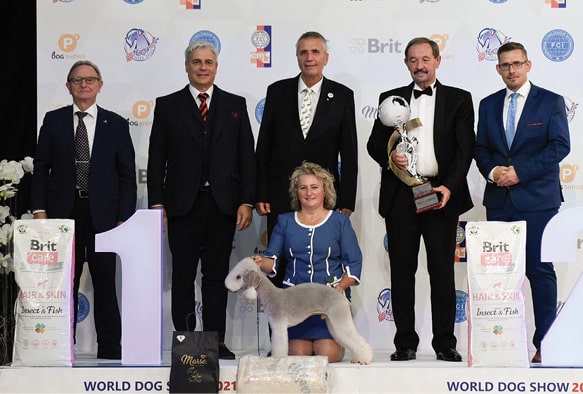FCI World Dog Show Brno 2021 | The last big event in the world of dog shows in Europe was Crufts 2019. By then, rumors were already circulating for days that a big pandemic was finding its way to Europe and the whole world. After many months, and numerous victims, during which most of the dog shows were canceled, the first signs of relief were showing. Most people in Europe proved to be vaccinated and this was the main condition to start thinking again about dog shows.
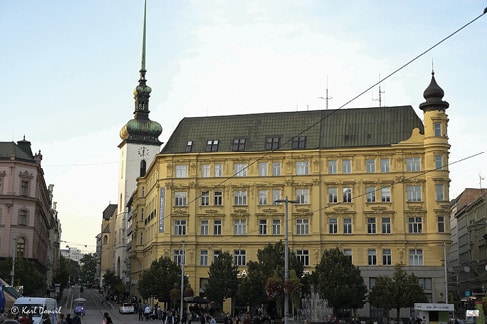
Important shows, like the FCI World Dog Show and European Dog Shows, were not canceled but were rescheduled, like Madrid. The FCI World Dog Show of Brno, however, was not one that was rescheduled but was planned for 2021. Anyway, it proved to be a risky choice as the Government of the Czech Republic had to be persuaded that a big show like this, attracting lots of people from many different countries, could happen within the strict rules of COVID prevention; in other words, ffp2-masks, social distancing, etc. This was of utmost importance, as the show would go on indoors. Outdoors, the rules were not that strict, and the wearing of masks was advised but not necessary. Until the last days before the show, things remained uncertain, and communication was very limited. The judges list was subjected to numerous changes as some could not (or were not allowed to) come in the end, and the people of the press could not be informed about how the show would look, i.e., one with time schedules, with a regular main ring, and normal finals, etc. It was pure horror, as we needed to book planes, trains, and hotels, and last minute reservations could prove to become very expensive. And most of all, a strong suspicion arose that the show would even be canceled. However, as the date of the event got closer, rumors reached us that the show would probably become a rather regular one like we were used to, and finally, four days before the show, we were officially informed.
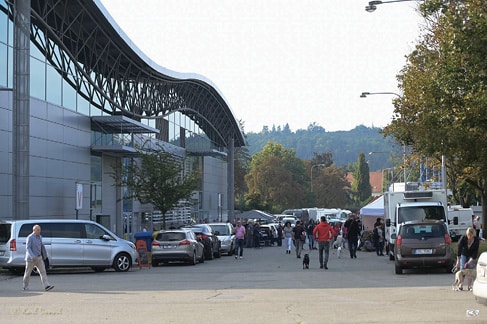
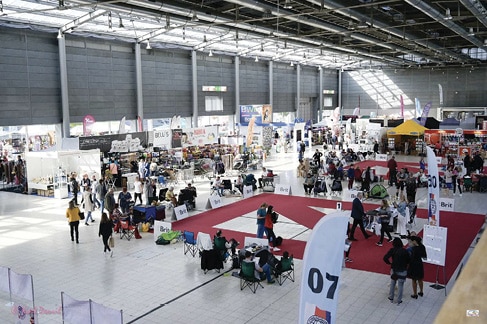
The whole situation certainly affected the number of entries. There were hardly any Russians, as they had serious difficulties leaving the country, and this weighed heavily on the final number of entries. Russia, and especially Czechia, would have had a big impact on the total number of entries. In the end, 12,161 entries proved not too bad, but the president of the Czech Kennel Club had expected at least 20,000 under normal circumstances. I have no idea if the final entry would be enough to cover the basic expenses for renting the halls and setting up everything, but I suppose that the managers of the halls would have given a discount; better than to have no rent at all. This probably accounted for the trade stand holders too and the sponsors. I had the impression that it was all a little more modest than we are used to.
On Wednesday, prior to the start of the FCI World Dog Show, there was a CACIB show and that allowed many foreign exhibitors to obtain extra CACIB titles, and eventually, finish their Czech Championship or Grand Championship. The total entry for this show was 3,161 dogs.
The Czech Kennel Club had previously organized a World Dog Show in 1966, and another one in 1990. In 2014, they hosted the European Dog Show. (They have certainly built up a lot of experience.) And yes, they managed again to organize another very nice show, especially with all the COVID restrictions in mind. They dared to take this high risk, and with a glance, they succeeded.
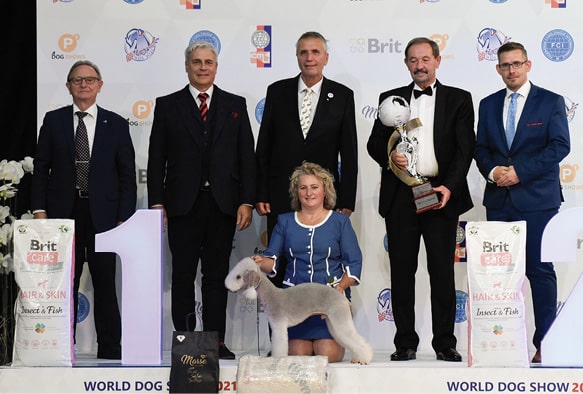
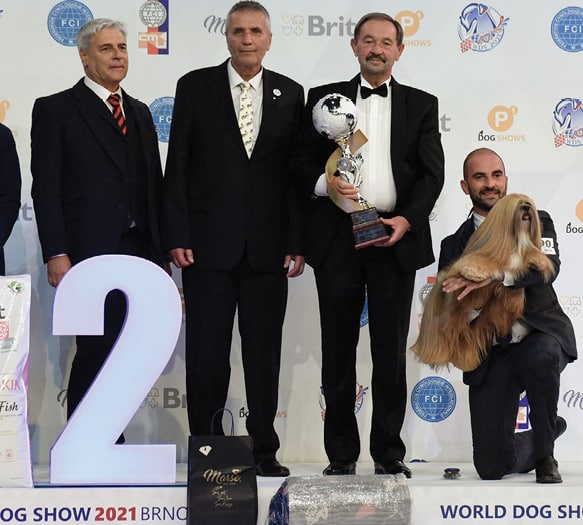
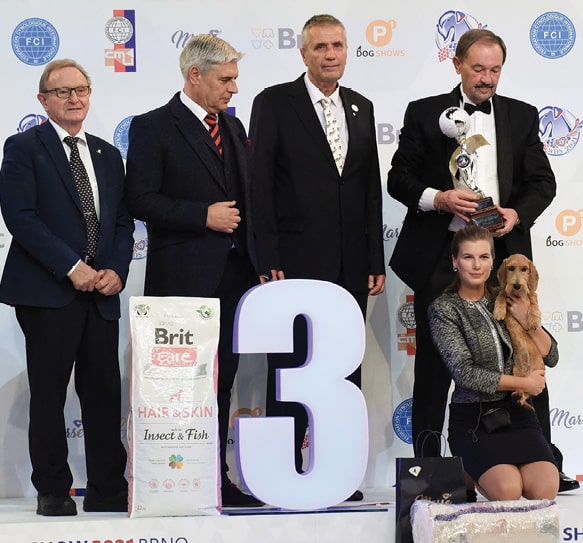
The show took place in the second largest city of the country, Brno, about 200 kilometers [124 miles] further to the southeast of Praag, nearby the border to Slovakia. The city has about 400,000 citizens, but its expo halls are vast, modern, and practical. They can host a show with easily double as many participants then this year’s COVID edition. The show took four days. (Five, if we also take the CACIB show into account.) On the first day, we still saw about 10 percent of the people wearing masks, but on day two this changed to hardly 0.1 percent. No trace of social distancing any longer, and I had the impression that COVID never happened. I did not see any COVID-safe checkpoints, but people confirmed that samples were regularly taken at the entrance. Maybe this is probably why the COVID measurements were not followed so strictly. Fortunately, due to the very nice, sunny, and perfect weather for an event like this, the doors of the halls were mostly open and people liked to walk outside in the open. Inside, there was no social distancing at all and it was crowded like any other show of this size.
Four halls were used for showing, the two biggest for the WDS, a smaller one for the club specials, and another for more club specials plus the indoor trade stands. The small halls were very dark inside, and your eyes had to adjust to the darkness before you were able to follow the judging in the rings. Outside, in between the two biggest halls, was a kind of street with more trade stands and many food, snack, and coffee stands spread around the halls. Thanks to the large parking areas around the halls, nothing was very far away. One thing was a fact: It was very clean everywhere! As I did not see any cleaning service—maybe I didn’t notice—I suppose that all the people were very disciplined. It makes such a big difference!
Hall F was reserved for the breed stands, offices, and of course, for the very large main ring. Along the long sides, we found the stairs on one side, and opposite to the podium, on the short sides, we found the entrance and exit, left and right of the huge black curtain and opposite to the VIP and Press seats. They proved far from ideal due to a difficult angle for taking good photos. On general request, this was changed from Day Two when the Press could take a seat at the bottom of the stairs. These could have been larger, as it was as good as full every single day while the exhibitors blocked the ways out of the halls; and this was not the safest situation in case of an emergency. The podium was very nice and tasteful, well-lit, and what I liked most of all were the professional ring stewards who kept very strict about the only way to allow the dogs to run. One judge tried to do it his way, but without success. He was corrected immediately. For the photographers, it was a blessing. That is one of the advantages of Media streaming; no chaos, but fixed scenarios! Another advantage was the strict timing, and thanks to that, the show ended every day perfectly on time.
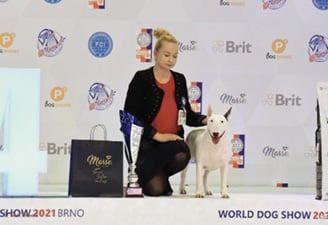
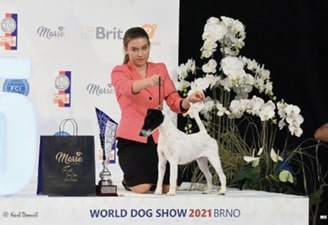
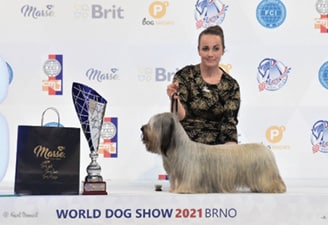
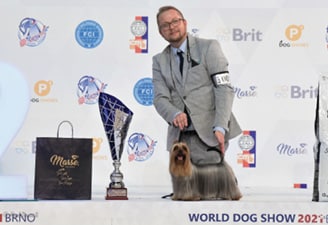
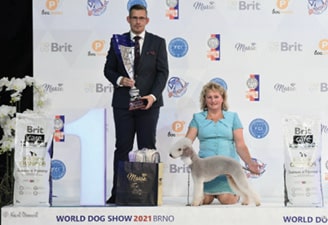
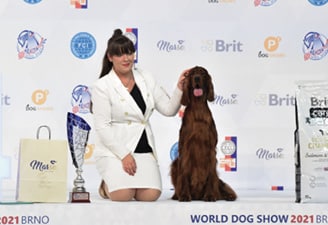
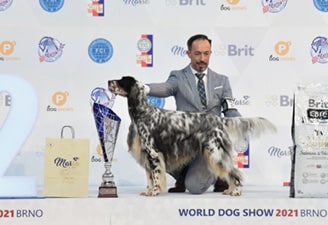
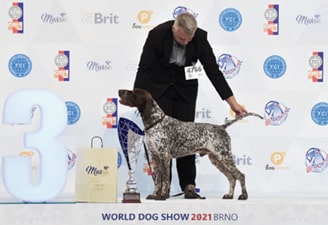
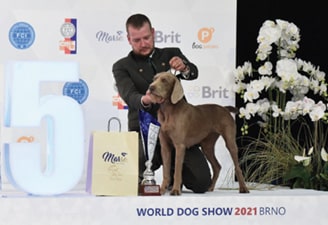
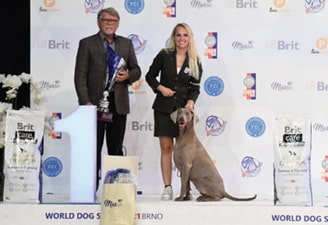
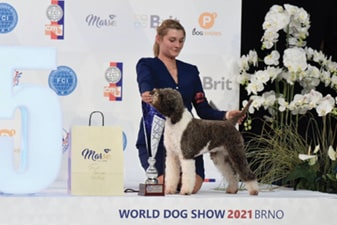
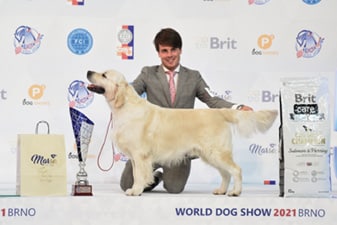
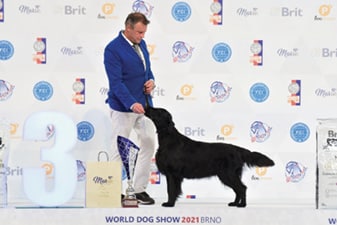
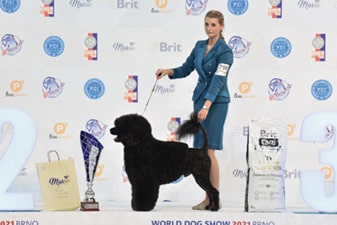
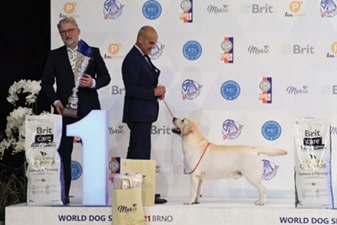
There was very little animation, and the ceremonial parts were kept very short. Every day, the finals started with a presentation of the National Breeds. Czechia has six National Breeds of which only two are officially recognized by the FCI. The others are still waiting for it. There is the wire-haired pointing dog, the Cesky Fousek, a dog with lots of similarities to the German Pointer and the wire-haired Weimaraner. More famous is the Cesky Terrier. The Chodsky Pes is a modern breed, a black and tan longhaired kind-of-shepherd; very versatile and a good family dog. This breed is only provisionally recognized by this FCI. This counts also for the Prague Ratter, a company dog comparable to the Miniature Pinsher, but smaller and lighter. Not recognized are the Czech Mountain Dog and the Czech Spotted Dog. The first is bred to pull sleds in the mountains, but is also a nice companion and used for different tasks like Search and Rescue. Its size is comparable to a Golden Retriever. He has large, colored plates, black or brown, on a white background. It is a recent breed. This also accounts, certainly, for the Bohemian (Czech) Spotted Dog, a dog that was bred for laboratory purposes (whatever that means) in the late 1950s, resulting in a tri-colored dog, medium in size, with dropped ears. They can be smooth or feathered. He looks smart and independent, with rather ordinary looks (with all due respect) like the ones we see a lot on farms. Let’s not forget a seventh breed, the Czechoslovakian Wolf Dog, a dog that also belongs to Slovakia. This is a very popular breed nowadays, the result of breeding dogs with wolves, and it looks very much like a European Wolf. One hundred and eighteen of them were entered at the show. It is an FCI recognized breed too. This dog is versatile and not shy like the Saarloos Wolfdog. Czechia seems to have many modern breeds, and I wonder if there is a coincidence with the fact that Brno is the city where the father of modern genetics, Gregor Mendel, worked and died.
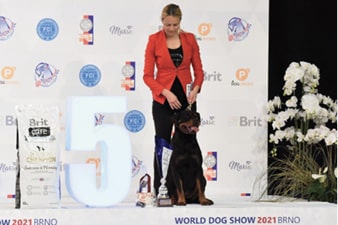
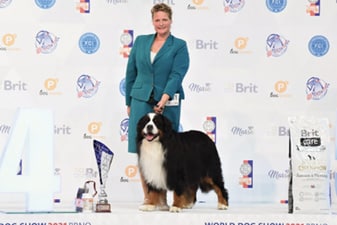
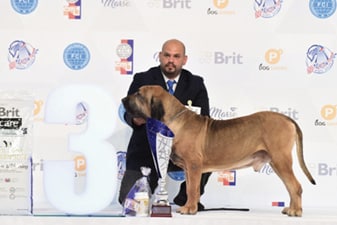
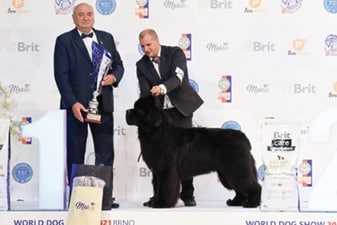
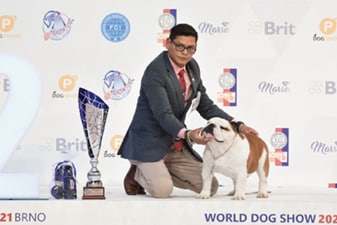
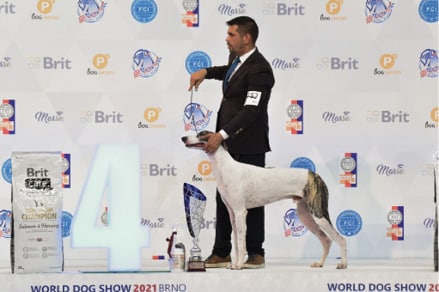
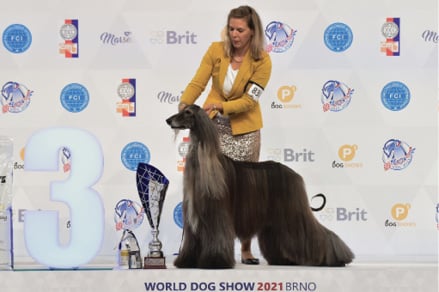
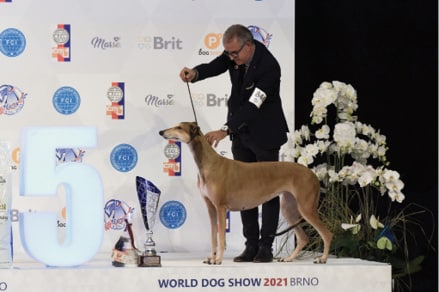
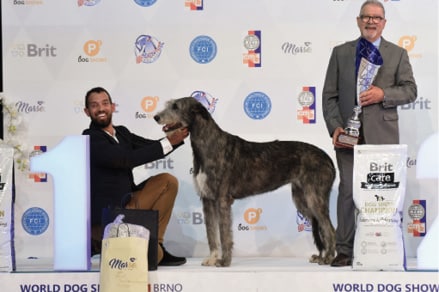
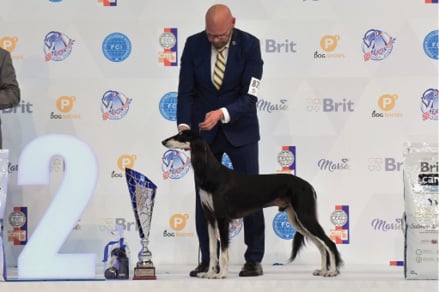
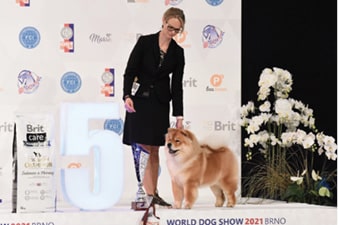
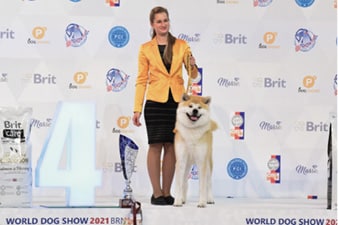
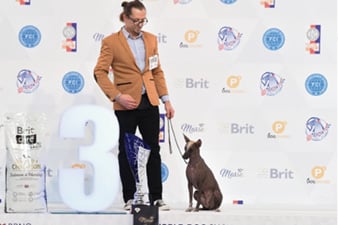
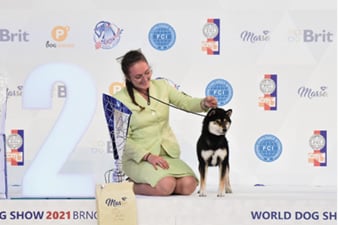
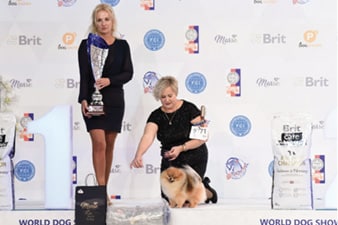
The carpet in the main ring was bright, and this was nice, but the logo of the WDS2021 was printed large and covered the center of the main ring. Several of the dogs were disturbed when they passed alongside, and some even jumped to the side—especially the puppies and juniors. The very large podium was brightly lit and tastefully decorated with orchids on both sides, and nothing in front of the dogs. The large numbers from 1 to 5 were lit from inside. The biggest part of the judging happened on the opposite side of the judges. It could have been more in the center of the ring, but apparently, nobody complained. Two nicely dressed ladies did the presentation, one in Czech, the other in English. Some point of attention is that the sound system was often much too loud; in the first place for the dogs. We should keep this more in mind that dogs hear so much better than we do!
Notwithstanding the traveling problem caused by the pandemic, 53 nationalities were entered according to the catalog. Whether or not they were all there is hard to tell. Anyway, this
is far from bad. The majority of the entries were local: 4,928. This is almost half of the total entries! It was very strange that only 462 entries were coming from Slovakia, the neighboring country that was once united in Czechoslovakia. Poland came next in numbers with 1,369 entries,
followed by Italy with 1,113, Germany with 638, and Hungary with 528. Only 26 dogs were entered from the United Kingdom and 11 from the United States. There were even dogs entered from as far as Mexico, with eight, Peru with seven, Australia with two, and even two from Ethiopia, one from the Philippines, and one from Argentina. Only 156 dogs were entered from Russia, far below what we are used to, and this made a big difference in the total number of entries. Russia usually sends in several hundred more dogs.
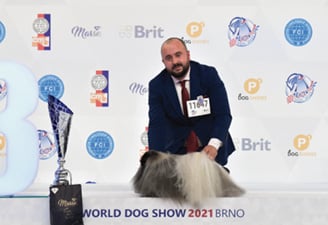
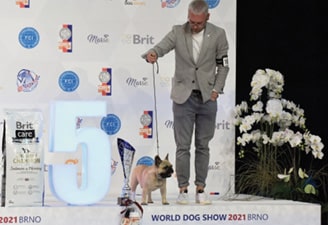
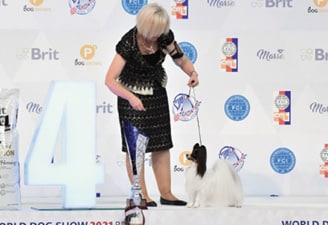
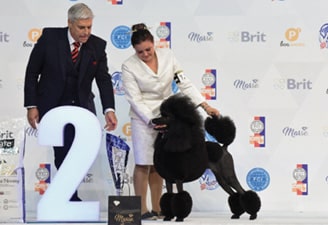
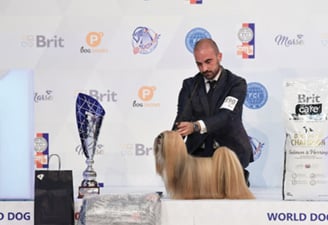
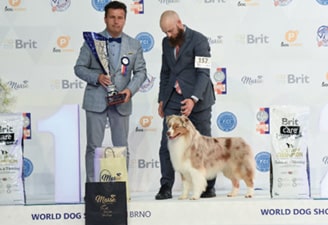
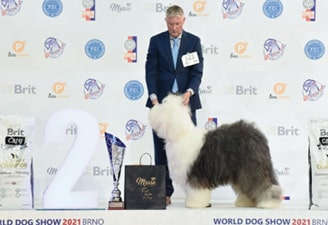
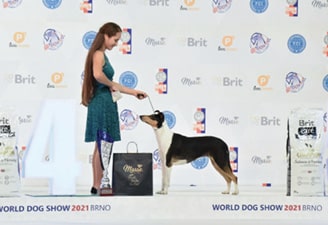
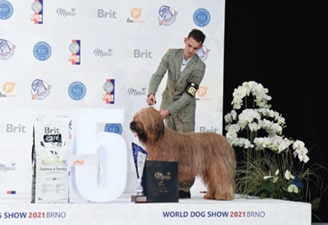
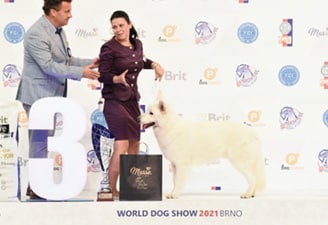
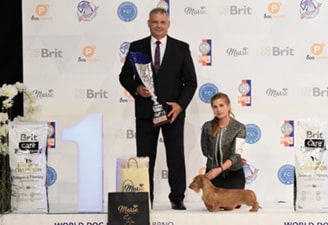
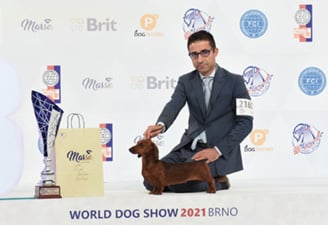
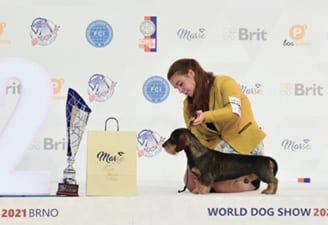
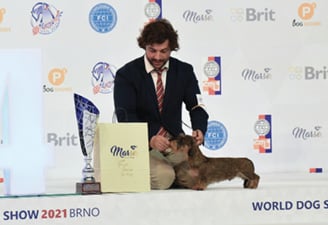
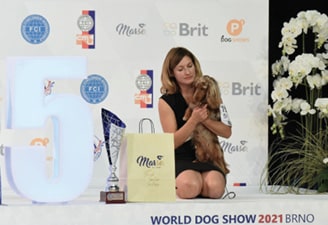
As I’ve already mentioned, a lot of judges canceled or were canceled due to the lower entries. In total, 125 judges were invited in the end and 48 of them were from the Czech Republic, plus another 15 from Slovakia. The remaining judges were all coming from 18 European countries, plus three from the UK. In the main ring, it was clear that the majority of judges were Czech judges, especially the more important judging like the FCI Groups and Junior Classes. A look into the catalogs indicates that, in general, the judges were well-charged with dogs, and several had largely over 100 in their ring. The exhibitors list was not according to the modern EU GDPR rules, as their complete addresses were mentioned. (I think the exhibitors don’t mind as it is an ideal way to find them if you are interested in a breed or a single dog.) A look at the breeds teaches me that 300 different breeds were shown. The most popular was the Dachshund in all of its nine varieties, with 494 of them, followed by the Poodle, also in its different colors and varieties in size, with 272 entries. This counts also for the Zwergschnauzers, 234, the German Spitzes, 214, and the Great Danes, 205. The real “first breed” was the Golden Retriever with 203 specimens, and from then on a long list of common and popular breeds followed. It is interesting to see that some breeds became more common, like the Porcelaine, the Hokkaido, and the Shikoku, each with 11 present. I was very pleased to see a Poitevin win Group 6. This is a French breed, living in large packs of 30 or more and used for the long hunt. It is a very elegant, large dog and seldom seen at shows outside France. Of course, like in any World Dog Show or European Dog Show, you always find a lot of very rare breeds, and that list is rather long. Better to come and see them for yourself!
This was a really good show, one like we are used to. Certain things were rather basic, others outstanding, but everything was there. What more could one want?
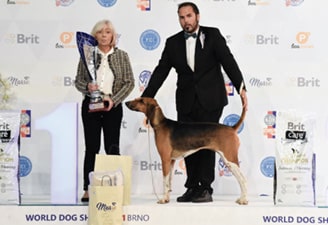
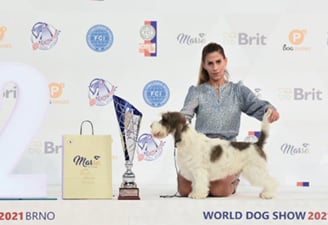
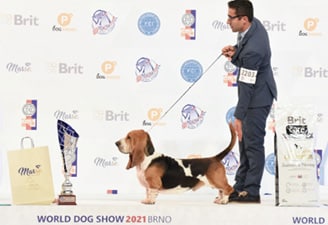
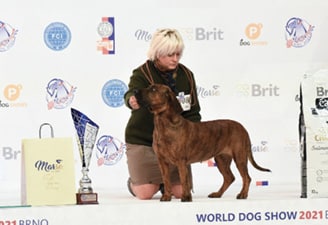
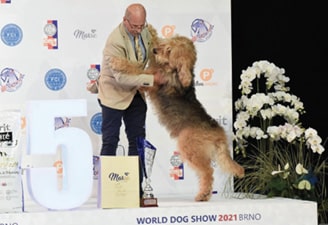
This show made history as the first post-pandemic FCI World Dog Show. At first, I was very upset and frustrated about the lack of information about how the show would look and would be organized. But once I was there, I could not but admire the Czech Kennel Club for the many difficulties they faced and had to overcome, and how they managed in the end. This was a really good show, one like we are used to. Certain things were rather basic, others outstanding, but everything was there. What more could one want?
Congratulations to the organization and to the Czech Kennel Club!
PHOTOS BY KARL DONVIL


